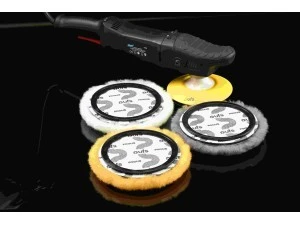
Thick polish plays an important role in car painting and maintenance processes. In this guide, we will detail what thick polish is, what it is used for, in which situations it is applied, and the differences between thick and fine polish.
What is Thick Polish?
Thick polish is a product widely used in the automotive industry, developed to repair deep scratches and damages on car paint. Due to its high content of abrasive material, this polish effectively removes problems such as deep scratches and paint defects. It is used to restore the car's paint to its original shine and smoothness, thereby maintaining the car's aesthetic appearance for long periods. Thick polish is especially indispensable in professional car care and detailing processes. It provides an ideal solution for correcting severe paint defects on the surface, helping car owners preserve the aesthetic appearance of their vehicles. Additionally, it prepares a solid base for subsequent protection and polishing processes. During this process, the polish corrects the paint surface at a microscopic level, resulting in a smoother surface. Thick polish is typically applied using a rotary or orbital polisher, spreading evenly on the surface to achieve the best results. This product, especially recommended by car care experts, significantly improves the appearance of the surface and removes defects without causing damage. For this reason, thick polish is considered an essential in car care.
Thick Scratch-Removing Polish
Thick scratch-removing polish is a specialized product used in car care, specifically designed to remove deep scratches and severe paint defects. These types of polishes contain a high concentration of abrasive materials and can effectively correct even the most challenging damages on car surfaces.
Deep scratches not only look unsightly on car surfaces but also reduce the vehicle's value. By using thick scratch-removing polish, the visibility of these scratches can be significantly reduced, making the car surface appear smoother and newer.
This polish can also be used to prepare the car's surface before painting. When deep scratches and other surface defects are removed, the new paint layer can be more uniform and smooth, resulting in a more professional appearance.
Professional painting and detailing services can be costly. By using thick scratch-removing polish, car owners can reduce the need for such professional treatments, saving both time and money.
In addition to removing scratches, this polish leaves a protective layer on the surface, helping to protect the vehicle for a longer period. This protective layer makes the vehicle more resistant to environmental factors.
Thick scratch-removing polish is generally easy to apply and does not require special tools or expertise for use. This provides a solution that car owners can apply themselves, but professional application is recommended for the best results.
Thick scratch-removing polish is an excellent option for car maintenance and repair, enhancing the aesthetic value of the vehicle by eliminating surface defects. This polish is an effective solution preferred by both professional users and car owners.
What is Thick Polish Used For?
The answer to the question of what thick polish is used for lies in the versatile benefits of this product in car maintenance. Thick polish is primarily used to remove deep scratches and abrasions on the car surface. When applied to the car surface, it quickly removes defects on the paint due to its high abrasive properties, leaving a smoother surface. This process is generally preferred when more significant and deeper damages need to be corrected.
Damages caused by various environmental factors such as oxidation stains, road salts, and bird droppings that form over time on car surfaces can also be minimized using thick polish. This polish removes the dull and oxidized layers on the surface, thereby restoring the vehicle's original color and shine. Additionally, it cleans the pores on the surface, allowing subsequent protective coatings to adhere better, which helps the paint to be preserved for a longer time.
When is Thick Polish Used?
Thick polish application is particularly necessary for specific conditions and surface defects. This polish is ideal for severe and deep scratches, painting errors that need to be corrected effectively, and other serious surface defects. Its high abrasive content is designed to quickly and effectively remove such defects.
- Deep scratches resulting from impacts in parking lots or traffic can be treated with thick polish. If these damages penetrate deeper layers of the surface, thick polish provides an ideal solution.
- Vehicles exposed to the sun or harsh weather conditions for extended periods may have their paint become dull and oxidized. Thick polish is used to correct such damages, as its strong formula removes the oxidized layer and reveals the healthy paint layer underneath.
- Paint transfers caused by other vehicles or environmental factors can be cleaned using thick polish. This polish removes unwanted substances on the surface, preserving the vehicle's original paint surface.
- During classic car restorations or special vehicle restorations, the use of thick polish ensures the original paint surface is restored while preserving it as much as possible. In such projects, restoring the surface to its former shine and smoothness is essential.
- Before applying a new paint layer to the car surface, surface preparation with thick polish increases paint adhesion and, consequently, the finish quality.
These are examples of when thick polish should be used, and polish application is a maintenance method that increases the vehicle's overall value as well as correcting surface defects. In each case, the use of thick polish is an important step in maintaining and enhancing the vehicle's aesthetic and structural integrity.
What are the Differences Between Thick and Fine Polish?
The differences between thick polish and fine polish are based on their intended uses and application methods. While both types of polish are important for car care, they provide different results depending on specific needs.
- Abrasive Level: The most noticeable difference is the size of the abrasive particles contained in each type of polish. Thick polish usually has larger abrasive particles, making it suitable for removing deeper scratches and serious paint defects. On the other hand, fine polish contains finer abrasives and is ideal for removing light scratches or minor surface defects.
- Post-Application Results: Using thick polish generally results in a smoother surface due to a more aggressive surface treatment, but this process may remove some paint. Fine polish is less aggressive and, when used as the final polishing step, provides high gloss, giving the car surface an excellent finish.
- Intended Uses: Thick polish is generally preferred in car restoration projects or when severely damaged surfaces need to be corrected. Fine polish, on the other hand, is ideal for routine maintenance and minor surface corrections, which is particularly important when car owners want to display their vehicles.
- Protective Properties: Both types of polish help protect the surface, but fine polish generally provides extra shine and protection when applied as a final coat.
- Application Techniques: Applying thick polish usually requires more care and professionalism because it can damage the paint surface if misused. Fine polish is a more forgiving product and generally does not cause damage even in the case of improper application.
Both thick polish and fine polish are important parts of a car care routine, and determining which to use in specific situations depends on the vehicle's needs and the condition of the surface. Car owners and care professionals prefer to use both types of polish in appropriate ways to achieve the best results.



